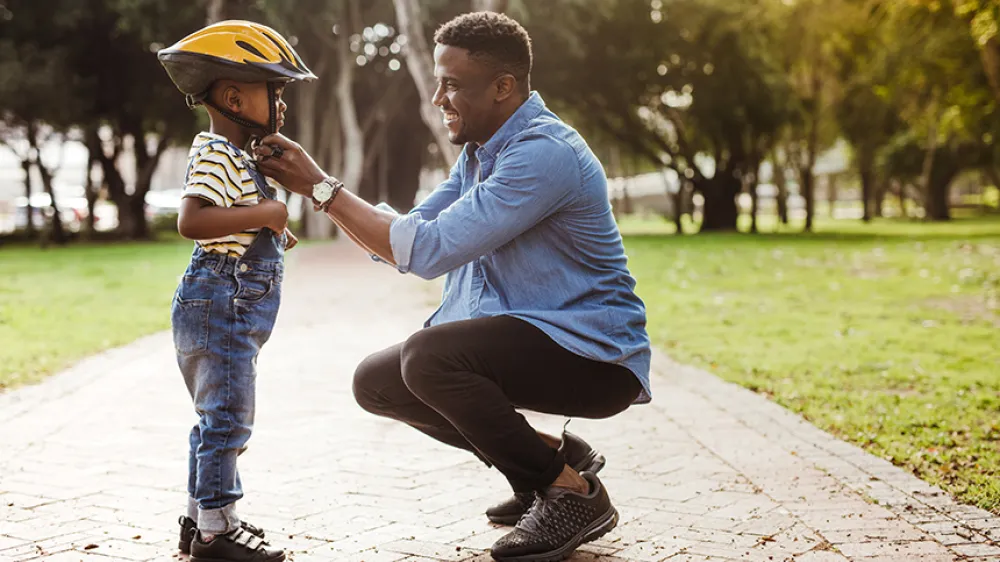Providing your location allows us to show you nearby locations and doctors.
5 summertime safety tips for kids

06/23/2022
Updated 7/11/2023
Learn about head, sun, water, insect and outdoor activity safety for kids
By Jay D'Orso, MD, Pediatrics and Internal Medicine, Nuvance Health Medical Practice Primary Care
Summer weather can make it easier to motivate your kids to get off the couch and away from their screens. Follow these tips to keep your family safe when you and your kids are enjoying the summer weather - by biking, hiking, swimming or just hanging out in the backyard.
Summertime for kids tip #1: Wear a helmet
When biking, skating or riding a scooter, make sure your kids are always wearing a helmet to prevent a head injury. Helmets can help absorb and cushion blows to the head and reduce the risk of serious head and brain injury by 85%.
Related content: Kids and concussions: Know the signs and when to seek treatment
When choosing the right helmet to wear, the National Highway Traffic Safety Administration recommends that the helmet is:
- Snug and does not slide side-to-side, forward or backward
- Level, sits squarely and fully covers the top of the forehead
- Stable with the chinstrap keeping it in place so it does not rock back and forth
Get a helmet your kids like, as this will make them much more likely to wear it. Lead by example and wear a helmet yourself.
It's important to always ride on the right side of the road, with traffic, and wear high visibility gear. Avoid riding at night.
Summertime for kids tip #2: Heat and sun protection
If your kids are going to be spending time in the hot summer sun, take proper steps to avoid conditions such as heatstroke, dehydration and sunburn. Supervise your kids and make sure they get enough to drink - water is the best choice - especially if they are running around in the sun or sweating in the heat. Remember, have your kids drink water before they feel thirsty. This is the best way to prevent dehydration, cramps and fatigue.
Always apply sunscreen on your kids' skin before they go outside. The American Academy of Pediatrics (AAP) recommends using SPF 15 or greater and reapplying at least every two hours, or after swimming or sweating.
Summertime for kids tip #3: Protection from insects
One of the hazards of the outdoors is insect bites or stings. These can be painful, cause allergic reactions, contain toxins or even transmit illnesses such as Lyme disease. There are several ways to protect kids against insect bites and stings, including:
- Use an insect repellent that contains 10% to 30% of the active ingredient DEET. Always check that you are using the appropriate amount of insect repellent based on age, and reapply it after swimming according to instructions. Do not use insect repellent with DEET for infants younger than two months old.
- Avoid wearing flowery clothing, bright colors, and perfumes because these can attract insects.
- Many experts think that ticks need to be attached for at least 24 to 48 hours to cause tick-related illnesses such as Lyme disease. Check your kids for ticks every night to reduce the risk of getting Lyme disease or other tick-borne illnesses.
Related content: Avoid ticks and prevent Lyme disease
Summertime for kids tip #4: Water safety
Playing in the water can be a lot of fun for kids and families, but it's also one of the most dangerous activities for children. Drowning is one of the leading causes of injury and death in the United States.
Children - particularly age five and younger - can be especially vulnerable. To keep your kids safe around water, follow these guidelines:
- If you have any type of water near your house, make sure kids cannot get outside on their own. Keep pools fenced in and make sure doors and gates are self-locking.
- Do not leave kids near water unsupervised. If your child is five years old or younger, practice "touch supervision" around water, always keeping your child within arm's reach.
- Adult supervisors should have CPR training.
- Be careful around inflatable pools because kids may lean on the sides and fall in.
- Avoid stagnant water.
- When boating, the U.S. Coast Guard recommends that kids wear life jackets. In Connecticut, all children 12 and under must always wear a life jacket on a boat.
- Always seek emergency medical attention after a near-drowning, especially if your child was submerged for more than five minutes; life support (e.g., CPR, rescue breathing) was administered 10 minutes or more from the time of the event; or resuscitation took more than 25 minutes from the time of the event.
Summertime for kids tip #5: Neighborhood safety
Playgrounds: Take precautions to reduce your child's risk of injury. Make sure that the ground underneath and around the play area is a soft material such as rubber, mulch, sand or wood chips. Make sure the playground is clear of tripping hazards, like tree stumps, and has guardrails that are in good condition. Supervise your child, particularly when on swings, monkey bars, or climbing sets.
Fireworks: Kids and adults alike love watching fireworks. It can be tempting to go to your neighbor's home to watch them set off a display, or even purchase fireworks yourself. However, fireworks - even "safe" fireworks such as sparklers - can reach temperatures exceeding 1,800 degrees and cause serious burns.
One-quarter of fireworks injuries to kids occur when they are bystanders, and many of the rest occur while they are playing with fireworks under adult supervision. If you and your family are going to enjoy fireworks, the safest way to do so is by attending an event managed by trained professionals. Avoid buying fireworks for home use.
Trampolines: As attractive and fun as they are to kids, trampolines are a common causes of serious injury to them. According to data from the U.S. Consumer Product Safety Commission, in 2014 alone, more than 100,000 trampoline-related injuries were treated in an emergency department.
The AAP does not recommend trampolines in any setting. However many kids use them anyway. While I also don't endorse trampoline use, the following information might be useful to lower injury risk:
- Make sure the trampoline has a net and shock-absorbing pads covering the springs, hooks, and frames.
- Always supervise your kids on a trampoline.
- Allow only one person on at a time.
- Don't allow kids under age six to use a full-size trampoline.
- Prohibit your kids from doing somersaults or flips.
- Keep kids from going under the trampoline where someone bouncing above could injure them.
- If you own a trampoline, verify your insurance covers trampoline-related injury.
The bottom line: Now more than ever, it is important for children to put down the devices, enjoy the great weather, and spend time outdoors with family and friends. Have a safe, healthy and fun summer by following head, sun, water, insect and outdoor activity safety tips.
At Nuvance Health, pediatricians and family medicine providers see children of all ages. Learn more about primary and pediatric care.

